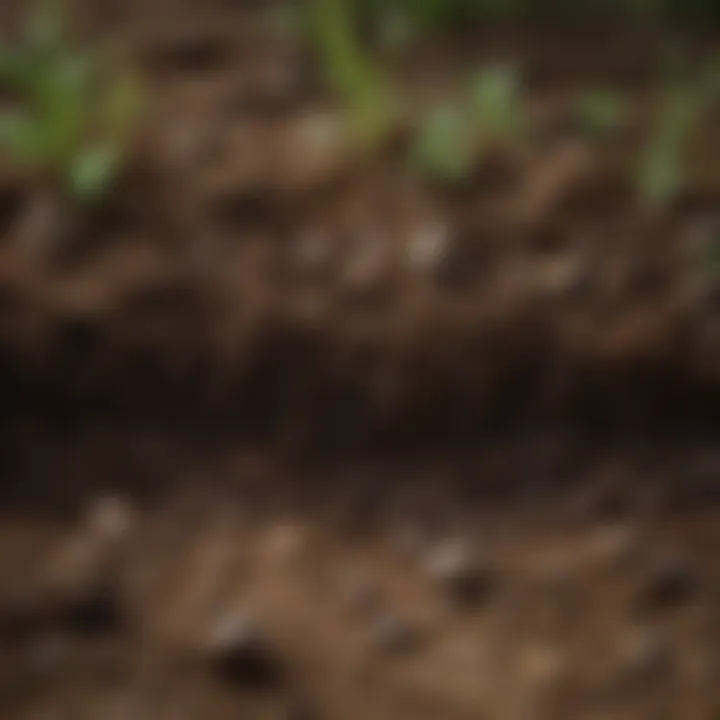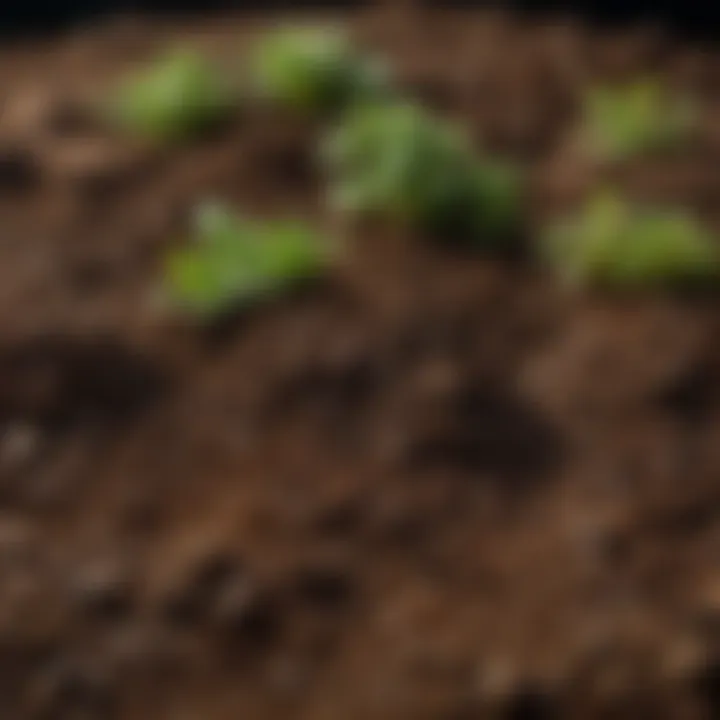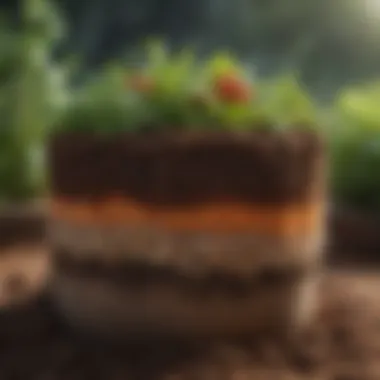Choosing the Right Soil for Your Above Ground Garden


Intro
Choosing the appropriate soil for your above ground garden is vital for successful gardening. Unlike traditional in-ground gardens, above ground gardens rely heavily on the quality of the soil you select. In this guide, we will explore the essential components of soil, the various types suitable for your needs, and how you can maintain soil health to promote optimal plant growth. Understanding soil composition, pH levels, and drainage requirements are just a few critical areas we will cover.
Good soil acts as a foundation for any garden, affecting nutrient availability, moisture retention, and aeration. By mastering the art of soil selection, you will not only enhance your gardening skills but also ensure that your plants thrive throughout the growing season.
Soil Composition
Soil is more than just dirt; it comprises minerals, organic matter, air, and water. Minerals typically make up about 45% of soil volume. These include sand, silt, and clay, each contributing distinct properties. Organic matter accounts for approximately 5% and consists of decomposed plant and animal material. This organic matter is crucial for soil fertility and structure. Air and water occupy the remaining space, both playing essential roles in supporting plant life.
Key Components of Soil
- Minerals: The essential elements that provide nutrients.
- Organic Matter: Promotes nutrient exchange and improves soil structure.
- Water: Critical for plant health, aids nutrient transport.
- Air: Provides oxygen to roots and beneficial microorganisms.
This combination creates an environment where plants can develop roots, absorb nutrients, and grow strong.
Suitable Soil Types for Above Ground Gardens
Selecting the right soil type is crucial for ensuring successful plant growth. There are several options to consider:
Potting Soil
Potting soil is a blend specifically designed for container gardening. It typically contains peat moss, vermiculite, and perlite. This blend provides excellent drainage and aeration, which is critical for root health.
Garden Soil
Garden soil is often made from a combination of topsoil, compost, and other organic materials. This type of soil is rich in nutrients, making it suitable for a variety of plants. Ensure that any garden soil you select is free from pests and contaminants.
Native Soil
Using native soil involves taking soil from your yard or garden. While it can be beneficial, it often lacks the necessary amendments like compost or sphagnum moss, which enhance drainage and nutrients. If you choose this option, be sure to amend it properly.
Specialty Soil Blends
There are specialized soil blends available tailored for specific plants, such as cacti or orchids. These blends usually have a unique mixture of organic and inorganic materials that suit the particular needs of such plants.
Maintaining Soil Health
Soil health is not static; it requires ongoing attention and care. Here are some practices to ensure your soil remains productive:
Seasonal Maintenance Checklist
- Spring: Test soil pH, add compost, and mix effectively.
- Summer: Monitor moisture levels, consider mulching to retain water.
- Fall: Prepare for winter by adding organic matter and protecting the soil surface.
- Winter: Cover with leaves or mulch to improve structure and prevent erosion.
Cleaning and Organization Tips
- Regularly remove debris and spent plant material to prevent disease.
- Store tools properly and keep your garden tidy to enhance productivity.
Ultimately, understanding how to choose and maintain soil is critical for any above ground garden. By implementing these techniques and being mindful of the soil components, you create an enriching environment for plants to thrive.
"Good soil improves our ability to grow healthy plants and contributes to sustainable gardening practices."
In summary, selecting the right soil blends and managing them effectively empowers gardeners. With this knowledge, your above ground garden can flourish and deliver an abundant yield.
Preface to Above Ground Gardening
The topic of above ground gardening is increasingly important as urban dwellers seek innovative ways to cultivate plants in limited spaces. This method allows enthusiasts to grow a diverse range of plants without the need for traditional ground soil. Above ground gardening can take many forms, from raised beds to container gardens, and it provides unique opportunities for both aesthetic pleasure and food production. Understanding the essentials of this topic can empower gardeners to make informed choices that enhance their gardening experience.
Defining Above Ground Gardening
Above ground gardening refers to the cultivation of plants in elevated structures rather than in the ground. This can involve using pots, troughs, or elevated garden beds. With this method, the gardener controls many variables that affect plant growth, such as soil quality, drainage, and sunlight exposure. The flexibility of above ground gardening allows for growing in various environments, including patios, balconies, and urban rooftops.
Benefits of Above Ground Gardening
The practice of above ground gardening comes with notable benefits:
- Soil Control: Gardeners can create custom soil mixes tailored to specific plants. This leads to healthier growth.
- Pest Management: Elevated gardens are less accessible to common ground pests, which can lead to reduced pest infestation.
- Accessibility: This method can be especially beneficial for individuals with mobility issues. Elevated beds reduce the need to bend down, making gardening more accessible.
- Extended Growing Season: Above ground gardens often warm up faster in spring. This allows for an extended growing season.
- Aesthetics: Well-designed above ground gardens can enhance the visual appeal of home landscapes.
Above ground gardening is not just a trend; it is a practical solution for adapting gardening practices in response to urbanization and space shortages. As this article progresses, the importance of selecting the right soil will be emphasized. The next sections will explore how to optimize soil choice for above ground gardening.
Importance of Soil Selection


Soil as a Growth Medium
Soil provides not just a foundation but also sustenance for plants. It is a complex ecosystem composed of minerals, organic matter, air, and water. This combination allows for nutrient exchange and the support of plant health. The growth medium plays an essential role in how well water and nutrients are retained and transferred to the roots.
For instance, soil rich in organic matter tends to retain moisture better. This is important in above ground gardens where evaporation rates can be higher due to exposure. When selecting soil, it is crucial to seek blends that promote aeration and drainage while holding nutrients in a form usable by plants.
Using high-quality soil can lead to better plant vigor, higher yields, and increased resistance to pests and diseases.
Relationship Between Soil Quality and Plant Health
The quality of soil directly correlates with the health of plants. Healthy soil provides balanced nutrients, which are vital for photosynthesis, growth, and reproduction. Poor soil quality can lead to nutrient deficiencies, stunted growth, and increased susceptibility to diseases. Factors like soil pH, texture, and composition influence how well the soil can support healthy plant life.
A study from en.wikipedia.org shows that nutrient deficiencies can dramatically affect plant growth. Examples of deficiencies include a lack of nitrogen, which can cause yellowing of leaves, or insufficient phosphorus, which leads to poor root development. Ideal soil should allow optimal root penetration and support water retention, minimizing stress on the plants.
"Healthy soil is the foundation of a thriving garden; without it, even the best seeds cannot flourish."
Understanding the nuances of soil quality leads to informed decisions when selecting soil for your above ground garden. Regular testing and monitoring of soil can help in managing its quality, ensuring plants receive the best possible growth environment. In summary, soil selection is not just a choice but a foundational component for successful gardening.
Components of Soil
The significance of soil composition in above ground gardening cannot be overstated. Each component of soil plays a critical role in determining its fertility and overall health. Understanding these components not only enhances plant growth but also informs gardeners about the best practices for soil maintenance. This section will elaborate on three vital components: organic matter, mineral components, and soil texture and structure. Each of these elements influences how well your plants will thrive in an above ground garden.
Organic Matter
Organic matter is essential for healthy soil. It consists mainly of decomposed plant and animal materials. The presence of organic matter in soil provides a variety of benefits:
- Nutrient Supply: It serves as a reservoir of nutrients that are gradually released to plants. Nutrients such as nitrogen, phosphorus, and potassium are crucial for plant growth.
- Improved Soil Structure: Organic matter helps to bind soil particles together, which enhances the soil structure. This increase in structure leads to better aeration, drainage, and moisture retention.
- Microbial Activity: The decomposition of organic materials promotes the proliferation of beneficial microorganisms. These microbes play a key role in nutrient cycling and disease suppression.
Gardeners should consider integrating compost into their soil mix to maximize organic matter content. Composting kitchen scraps and yard waste is an easy way to create nutrient-rich organic matter for your garden.
Mineral Components
Mineral components of soil are primarily the inorganic materials that provide the physical structure of soil. These components include sand, silt, and clay, each contributing specific characteristics:
- Sand: This coarser particle allows for excellent drainage but can also lose nutrients rapidly.
- Silt: Finer than sand but coarser than clay, silt holds more moisture and nutrients compared to sand yet may have less drainage.
- Clay: While it retains nutrients and moisture effectively, clay can become compacted easily, restricting root growth and drainage.
The balance of these minerals affects soil texture, which in turn influences water retention, drainage, and aeration. Selecting the right combination of mineral components is essential for your plants to access the water and nutrients they need for optimal growth.
Soil Texture and Structure
Soil texture refers to the proportion of sand, silt, and clay present in the soil. Conversely, soil structure deals with how these soil particles aggregate together. Both characteristics play a significant role in a garden's ecosystem:
- Water Retention: The texture of the soil influences how much water it can retain. Sandy soils dry out quickly, while clay soils may retain too much moisture, potentially leading to root rot.
- Air Exchange: Good soil structure ensures that air can penetrate to the roots. This is crucial for root respiration and overall plant health.
- Erosion Resistance: Soils with fine particles like clay tend to be more erosion-prone if not managed properly.
To achieve the best soil texture and structure for an above ground garden, gardeners may need to combine different types of soil components. Regular aeration can also help maintain a healthy soil structure, ensuring roots have room to grow.
Takeaway: Soil components, including organic matter, mineral content, and soil texture, are foundational to the success of above ground gardening. Understanding and managing these components allows gardeners to create a thriving ecosystem for their plants.
Types of Soil for Above Ground Gardens
Choosing the right soil is essential for successful above ground gardening. Different types of soil cater to various plant needs and growth conditions. Knowing the characteristics of each soil type helps gardeners optimize growth and health of their plants. This section outlines the most common types of soil used in above ground gardens, discussing their composition and advantages.
Potting Soil
Composition of Potting Soil
Potting soil is a commercial growing medium designed for containers. It usually contains a blend of organic materials such as peat moss, compost, and bark. These components provide essential nutrients, good structure, and aeration. The presence of components like vermiculite or perlite also boosts drainage and moisture retention. This makes potting soil a favorable choice for many above ground gardening applications.
Advantages of Potting Soil
The key advantage of potting soil is its well-balanced nutrient content. It is designed to support healthy plant growth right out of the bag. This soil is lightweight, which allows for easy handling of containers. Moreover, potting soil typically includes fertilizers that promote early plant development. However, its reliance on organic matter can sometimes lead to quicker nutrient depletion compared to other soil types.
Seed Starting Mix
Composition of Seed Starting Mix
Seed starting mix is a specialized blend created for germinating seeds. It usually contains fine particles of peat moss, vermiculite, or perlite. This ensures excellent drainage while keeping adequate moisture for seed germination. Its lightweight composition allows young roots to penetrate easily and grow stronger.
When to Use Seed Starting Mix
Using seed starting mix is essential when beginning seeds indoors or outdoors. This soil is beneficial during the initial stages of plant growth. Its fine texture supports small seedlings which might struggle in coarser soil. After germination, transferring seedlings to potting soil can provide them with more nutrients for continued growth.


Garden Soil
Characteristics of Garden Soil
Garden soil refers to soil that has been specially formulated for outdoor gardening. It usually combines topsoil with organic matter, ensuring good nutrient levels and drainage. The presence of microbes and earthworms enhances its fertility. Additionally, garden soil tends to be heavier than potting mixes, providing stability for taller plants.
Best Uses for Garden Soil
Garden soil is best suited for in-ground planting or larger raised beds. Its robust structure supports the growth of vegetables and flowers alike. The natural components keep the soil healthy, but it is not ideal for small containers; in such cases, potting soil would be preferable.
Coconut Coir
Properties of Coconut Coir
Coconut coir is a byproduct of coconut husks, praised for its water retention properties. Its fibrous structure aids in aeration while simultaneously maintaining moisture. Coconut coir is a sustainable option, providing an eco-friendly alternative to peat. It is pH neutral, supporting a wide range of plants.
Advantages of Using Coconut Coir
One significant advantage of coconut coir is its ability to retain water, making it ideal for plants needing consistent moisture. It also helps prevent soil compaction, allowing for better root development. Its durability means it can be used multiple times, making it a cost-effective choice for many gardeners. However, professional guidance may be needed to address mineral content, as it is typically lower compared to traditional soil options.
Vermiculite and Perlite
Differences Between Vermiculite and Perlite
Both vermiculite and perlite are natural minerals that improve soil aeration and drainage. The key difference is that vermiculite retains moisture due to its sponge-like structure, while perlite is more effective at promoting airflow and drainage. This knowledge is critical when selecting which one to use based on specific plant requirements.
When to Use Each
Vermiculite is best used in moisture-loving plants or when starting seeds, as it retains water well. On the other hand, perlite works best in mixtures requiring excellent drainage, such as for succulents or cacti. Understanding when to use each ensures optimal growth depending on the specific conditions needed for plants.
pH Levels and Soil Acidity
Understanding the pH levels and acidity of soil is crucial when creating an effective above ground garden. The pH scale ranges from 0 to 14, with 7 being neutral. Soil with a pH lower than 7 is acidic, while a pH higher than 7 is alkaline. Maintaining the right pH level helps ensure that plants absorb vital nutrients efficiently.
Proper comprehension of soil pH can influence overall plant health and yield. If the pH is too high or too low, plants may struggle to absorb nutrients, leading to deficiencies or toxicities. Thus, it becomes vital to test and monitor soil pH regularly to maintain an optimal environment for plant growth.
Understanding Soil pH
Soil pH signifies the concentration of hydrogen ions in the soil. A lower pH indicates higher acidity, while a higher pH shows alkalinity. Most plants prefer a slightly acidic to neutral pH, ideally between 6.0 and 7.0. However, certain plants can thrive outside of these parameters. It is essential to tailor soil pH levels to specific plant needs, which is particularly important in an above ground gardening context.
Testing soil pH involves using kits available in gardening stores or using home methods with substances such as vinegar and baking soda. Understanding the current pH of your soil aids in making informed decisions regarding amendments and plant choices.
Effects of pH on Nutrient Availability
Soil pH influences the solubility of nutrients in the soil. Different nutrients become available or unavailable at varying pH levels.
- At low pH (acidic): Nutrients like nitrogen, phosphorus, and potassium are generally available. However, essential elements like calcium and magnesium can become deficient.
- At high pH (alkaline): Calcium and magnesium are readily available, yet elements such as iron, zinc, and manganese tend to be less accessible, leading to deficiencies in these micronutrients.
Thus, managing soil pH is vital. It helps ensure that plants receive the necessary nutrients for healthy growth, making awareness of pH levels an integral part of gardening strategies.
Adjusting Soil pH
Altering soil pH requires an understanding of your target plants as well as the current soil composition. There are two main approaches to adjust soil pH: raising it and lowering it.
Methods for Raising pH
Raising soil pH typically involves adding alkaline materials to the soil. Common methods include:
- Lime Application: The most common method. Ground limestone is widely used to raise pH. It is accessible and relatively inexpensive, making it a practical choice for many gardeners.
- Wood Ash: A good alternative for calcium-rich soils. Wood ash can enhance the pH without leading to excessive buildup of lime.
Using these methods can benefit gardens by improving nutrient availability in acidic soils, allowing for optimal plant growth.
Methods for Lowering pH
When the soil pH is too high, certain amendments can help lower it effectively. Strategies include:
- Sulfur Addition: Elemental sulfur is a frequent choice. As the sulfur oxidizes in the soil, it decreases pH levels. It is suitable for long-term soil management.
- Organic Material: Compost and pine needles are also beneficial for maintaining an adequate level of acidity.
These methods help remediate alkaline soil, improving nutrient accessibility and supporting plant health.
Regular pH testing is essential for successful above ground gardening. Knowing soil acidity influences plant selection and overall garden wellbeing.


Soil Management Practices
Soil management practices are essential for successful above ground gardening. The choices you make about how you handle your soil greatly influence plant health and productivity. Healthy soil supports sustainable gardening, encourages biodiversity, and leads to better yields. This section explores various practices focusing on nutrient management, soil aeration, and moisture retention.
Nutrient Management
Managing nutrients is a crucial aspect of soil health. Plants require various nutrients, including nitrogen, phosphorus, and potassium, to thrive. The availability of these nutrients often depends on soil type and management practices. Soil tests can help identify nutrient levels and deficiencies, leading to better decision-making.
One commonly used practice is the addition of fertilizers. Organic fertilizers, like compost or well-rotted manure, are often preferred by gardeners interested in sustainability. These not only add essential nutrients but also improve soil structure and water retention. Chemical fertilizers, while effective, may lead to nutrient imbalances if used excessively.
It is important to consider timing when applying fertilizers. Incorporating nutrients during planting or growth stages can enhance plant development and yield. Understanding the specific nutrient needs of your plants will enable you to tailor your management approach effectively.
Soil Aeration
Soil aeration is another key practice in above ground gardening. Proper aeration improves soil structure and enhances root growth, allowing for better water and nutrient uptake. Compacted soil can limit root expansion, leading to stunted growth.
Aeration techniques include physically turning the soil or using tools like garden forks or aerators. Adding organic matter, such as mulch or compost, also contributes to better aeration by creating spaces in the soil. Elevated planting beds are another option as they tend to have less compaction than traditional ground gardens.
Regular aeration can prevent many soil-related issues, such as poor drainage and root rot, encouraging a robust garden environment.
Moisture Retention Techniques
Moisture retention is vital for plant health, particularly in above ground gardens where the soil can dry out more quickly. Managing moisture effectively requires a combination of practices. For instance, incorporating organic matter increases the soil's ability to retain moisture.
Mulching is another technique that provides a protective layer on the soil surface. This helps to minimize evaporation and maintain consistent moisture levels. Common mulching materials include straw, wood chips, and shredded leaves.
Drip irrigation systems can also aid moisture retention by targeting the root zone directly, reducing wastage and evaporation. Regular monitoring of soil moisture levels is essential. This can be easily done with moisture meters or by simply checking the soil's texture with your fingers.
"Moisture management is critical; it can mean the difference between flourishing plants and those that struggle."
In summary, effective soil management practices are essential for above ground gardening. By focusing on nutrient management, aeration, and moisture retention, gardeners can ensure a thriving garden that meets their expectations.
Common Issues with Soil in Above Ground Gardens
Selecting the right soil for above ground gardens can be a nuanced process. Even with the optimal mix, issues can arise. This section will delve into common problems encountered with soil in above ground gardening. Addressing these challenges is essential to enhance plant growth and maintain a thriving garden.
Soil Compaction
Soil compaction is a prevalent issue in above ground gardens. Over time, heavy rain, watering, or frequent foot traffic can lead to denser, less aerated soil. This compaction restricts root growth and limits the access of plants to essential nutrients and water.
To combat compaction, consider adding organic matter to the soil. Materials such as compost or peat moss can improve soil structure, making it more conducive for root development. Regularly turning the soil or incorporating mulch can also help maintain aeration.
Nutrient Deficiencies
Another common hurdle is nutrient deficiencies, which can manifest in various ways. Plants may display stunted growth or discolored leaves due to a lack of vital nutrients. The primary elements of concern include nitrogen, phosphorus, and potassium. If soil quality is lacking these nutrients, plants will not thrive.
To remedy nutrient deficiencies, utilize a balanced fertilizer that caters to the specific needs of your plants. Regular soil testing can help identify deficiencies before they impede growth. Notably, organic fertilizers like bone meal or fish emulsion can provide a slow-release option that benefits plant health over time.
Pest and Disease Management
Pests and diseases can be detrimental to an above ground garden, given the unique conditions it presents. Due to the confined environment, pests can quickly multiply and affect plants, leading to considerable damage. Common pests such as aphids and spider mites can weaken plants, reducing their productivity and even threatening their survival.
Preventive measures are crucial in pest management. Regular inspections of plants can help identify early infestations. Introducing beneficial insects, such as ladybugs, can naturally reduce pest numbers. Additionally, using organic pesticides, like neem oil, can mitigate pest problems without harming the plants.
It is best to maintain a clean growing environment. Removing plant debris and weed growth reduces hiding places for pests, and practicing crop rotation can minimize disease spread.
"Understanding and addressing these common soil issues is key to achieving a successful above ground garden. Proper management can lead to healthier plants and a more enjoyable gardening experience."
Ending
The conclusion of this article is a crucial element that encapsulates the key insights gathered throughout the discussion on soil selection for above ground gardens. It serves to remind readers of the significance of soil as a foundational component of successful gardening practices. By coordinating various aspects of soil selection, we can achieve greater plant health and higher yields.
Recap of Key Points
In summary, several critical points must be highlighted:
- The importance of choosing the correct soil for an above ground garden cannot be overstated. The type of soil influences water retention, nutrient availability, and root development.
- Various soil types, such as potting soil, seed starting mix, and coconut coir, each possess unique compositions that cater to different gardening needs.
- Soil acidity and pH levels can significantly impact plant health. Understanding how to effectively manage soil pH is essential for optimal growth.
- Common issues such as soil compaction, nutrient deficiencies, and pest management require proactive strategies to maintain soil quality.
These points converge to emphasize the necessity for informed decisions in soil selection, which enhances the gardening experience and results.
Encouraging Exploration and Experimentation
Gardening is not a static practice but rather an opportunity for exploration and experimentation. As you move forward with your above ground garden, consider trying different soil types based on the specific needs of your plants. Testing soil mixtures can lead to unexpected discoveries and improved gardening outcomes.
Moreover, engaging with gardening communities online, such as discussions on Reddit or relevant groups on Facebook, can provide valuable insights and shared experiences. Don't hesitate to seek advice or share your results. Each garden is unique, and personal adaptations to soil management can yield significant benefits.
Finding the right soil is an ongoing journey that can evolve with your skills and preferences. Embrace the process, stay curious, and continuously learn. Your garden will reflect your commitment and creativity.







